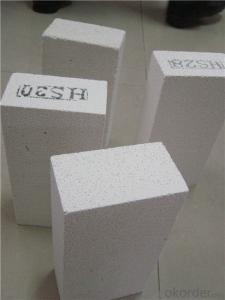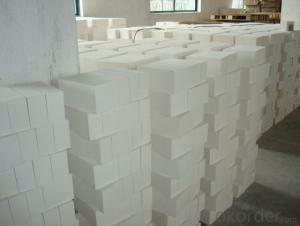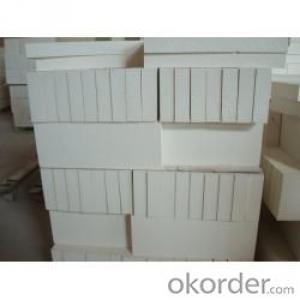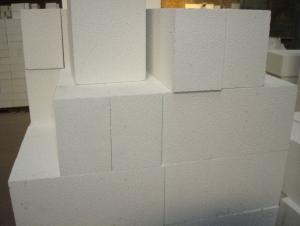High Alumina Fire Resistance Insulation Brick for Blast Furnace
- Loading Port:
- Qingdao
- Payment Terms:
- TT OR LC
- Min Order Qty:
- 1 m.t.
- Supply Capability:
- 1000 m.t./month
OKorder Service Pledge
OKorder Financial Service
You Might Also Like
Thermal Insulation Fire Clay Brick
Refractory brick is a block of refractory ceramic material used in lining furnaces, kilns, fireboxes, and fireplaces.
We provide high quality Refractory Fire Bricks that are used on wide range in the various industries like Cement, Glass and Steel. Refractory Fire Bricks are provided as per the quantity and specifications required by the customers. We provide an extensive range of Refractory Fire Bricks at reasonable prices that depend upon the quantity ordered.
Application
Insulating Fire Brick are used for the lining of converter, alternating current arc furnace, direct Current arc furnace and the ladle slag line, etc.
Company Advantage
(1)Long Insulating Fire Brick manufacture history: 25 years manufacturer
(2)Advanced equipment
(3)Diversification of production standards: ISO ANSI FEPA JIS ASTM
(4)Professional marketing team and after-sale service
Insulating Fire Brick main feature:
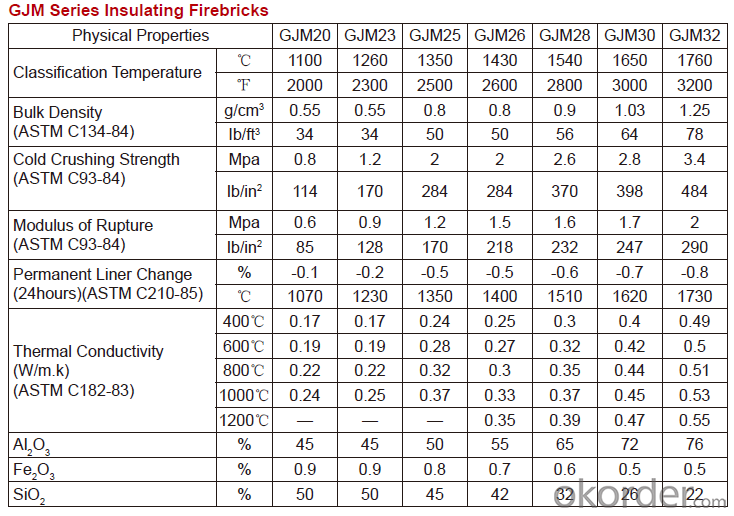
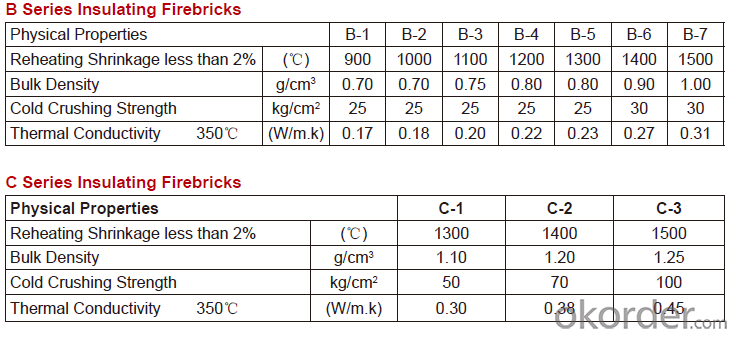
Equipment
1 unit of Ceramic Abrasive (SG Abrasive) pilot production line
2 units of Compact grain Abrasive pilot production lines
1 unit of high-end coated abrasives (abrasive cloth) production line
2 units of Boron Carbide production lines
Q1 What’s the transport method?
A1 FCL delivery goods with wooden pallet or wooden case by sea; If LCL delivery, must with wooden case; Sometimes need open top, flat rack or bulk cargo.
Q2 What’s the required payment term?
A2 Generally 30% TT as the prepayment, 70% TT before delivery. If need, 100% Irrevocable Letter of Credit or negotiation.
Q3 Which country are our products exported to?
A3 Apart from entire Chinese market, the US, Russia, Japan, Korea, Australia and some Southeast Asian Nations.
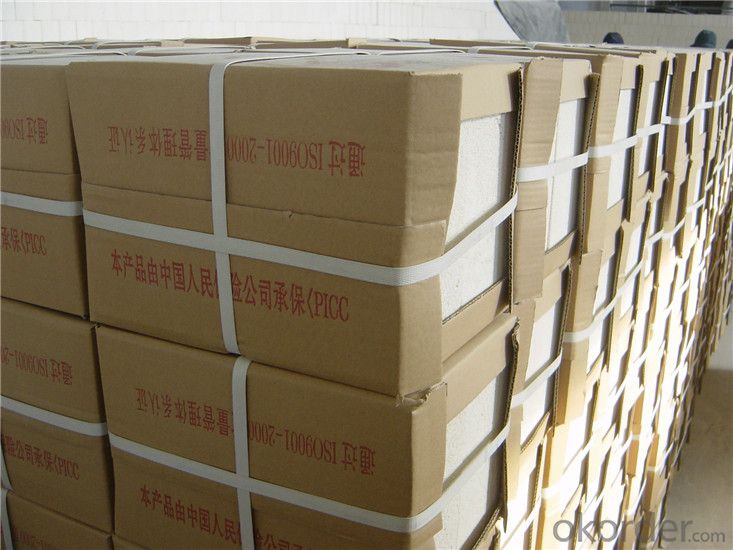

- Q:Can insulating fire bricks be used in drying ovens?
- Yes, insulating fire bricks can be used in drying ovens. These bricks are designed to withstand high temperatures and provide insulation, making them suitable for use in ovens where drying processes occur. They help to maintain a consistent and efficient heat distribution, ensuring effective drying of the materials inside the oven.
- Q:Are insulating fire bricks resistant to chemical attack?
- Yes, insulating fire bricks are generally resistant to chemical attack. They are designed to withstand high temperatures and are made from materials that are chemically inert, making them suitable for various industrial applications where exposure to chemicals is a concern. However, the specific resistance may vary depending on the type of chemical and concentration, so it is important to consider the specific chemical environment when selecting insulating fire bricks.
- Q:Are insulating fire bricks resistant to insects and rodents?
- Yes, insulating fire bricks are generally resistant to insects and rodents due to their dense and solid construction, which makes it difficult for pests to penetrate or damage them.
- Q:Are insulating fire bricks resistant to gas permeability?
- Yes, insulating fire bricks are resistant to gas permeability. They have low porosity and high density, which prevents the penetration of gases, making them an effective barrier against gas permeation.
- Q:How do insulating fire bricks compare to other refractory materials?
- Insulating fire bricks (IFBs) are refractory materials specifically designed for thermal insulation in high-temperature environments. They offer several distinct advantages compared to other refractories. To begin with, IFBs have a lower density, making them lighter and easier to handle. This characteristic allows for quicker and more efficient installation, reducing labor costs and time. Moreover, IFBs possess exceptional insulating properties, resulting in high heat transfer resistance. This insulation minimizes heat loss and conserves energy, making them highly efficient in kilns, furnaces, and boilers. Additionally, this advantage contributes to lower operating costs and improved energy efficiency. In addition, IFBs display good thermal shock resistance, enabling them to endure rapid temperature changes without cracking or spalling. This quality is vital in applications with repeated heating and cooling cycles, ensuring a longer lifespan and lower maintenance costs. Furthermore, IFBs have a high melting point, enabling them to withstand extremely high temperatures without deforming or losing their structural integrity. This makes them suitable for environments with temperatures reaching up to 3000°F (1650°C). Lastly, IFBs are generally more cost-effective than other refractory materials like dense firebricks or castables. Their lower density and insulation properties allow for thinner linings, reducing overall material costs. Additionally, the ease of installation and reduced labor requirements further contribute to cost savings. In conclusion, insulating fire bricks offer numerous advantages in comparison to other refractory materials. They provide excellent thermal insulation, are lightweight, possess good thermal shock resistance, can endure high temperatures, and are cost-effective. These qualities make them a popular choice for a wide range of high-temperature applications.
- Q:Can insulating fire bricks be used in the construction of pottery extruders?
- Using insulating fire bricks in the construction of pottery extruders is a reliable and effective choice because these bricks have high heat resistance and insulation properties. They are well-suited for applications involving high temperatures, such as pottery kilns and extruders. The durability and longevity of the extruder are ensured as these bricks can withstand the intense heat generated during the pottery extrusion process. Furthermore, their insulation properties help maintain a consistent temperature within the extruder, which is crucial for achieving precise and consistent results in pottery production.
- Q:Are insulating fire bricks resistant to thermal shock cracking?
- Yes, insulating fire bricks are specifically designed to withstand thermal shock cracking due to their high resistance to sudden temperature changes.
- Q:Outside brick wall, inside brick wall how to return a responsibility?
- In general, the wall of the building and outdoor harsh environment, so the general exterior wall tiles with full ceramic tile surface, then is the kind of uneven, and the appearance of the size deviation of brick is relatively large.
- Q:What is mullite insulation brick?
- Mullite brick, according to different density can be divided into: lightweight mullite brick and heavy mullite brick;
- Q:Can insulating fire bricks be used as insulation in walls and roofs?
- Yes, insulating fire bricks can be used as insulation in walls and roofs. Insulating fire bricks are made from lightweight materials that have excellent thermal insulation properties. They have low thermal conductivity, which means they can effectively reduce heat transfer through walls and roofs. This makes them a suitable choice for insulating buildings and improving energy efficiency. Additionally, insulating fire bricks are durable and fire-resistant, making them a safe option for insulation. However, it is important to note that insulating fire bricks are typically used in high-temperature applications such as furnaces and kilns, so they may not be the most cost-effective or practical choice for all wall and roof insulation needs. Other insulation materials designed specifically for building applications may be more suitable in terms of cost, ease of installation, and overall performance.
1. Manufacturer Overview |
|
|---|---|
| Location | |
| Year Established | |
| Annual Output Value | |
| Main Markets | |
| Company Certifications | |
2. Manufacturer Certificates |
|
|---|---|
| a) Certification Name | |
| Range | |
| Reference | |
| Validity Period | |
3. Manufacturer Capability |
|
|---|---|
| a)Trade Capacity | |
| Nearest Port | |
| Export Percentage | |
| No.of Employees in Trade Department | |
| Language Spoken: | |
| b)Factory Information | |
| Factory Size: | |
| No. of Production Lines | |
| Contract Manufacturing | |
| Product Price Range | |
Send your message to us
High Alumina Fire Resistance Insulation Brick for Blast Furnace
- Loading Port:
- Qingdao
- Payment Terms:
- TT OR LC
- Min Order Qty:
- 1 m.t.
- Supply Capability:
- 1000 m.t./month
OKorder Service Pledge
OKorder Financial Service
Similar products
New products
Hot products
Related keywords
